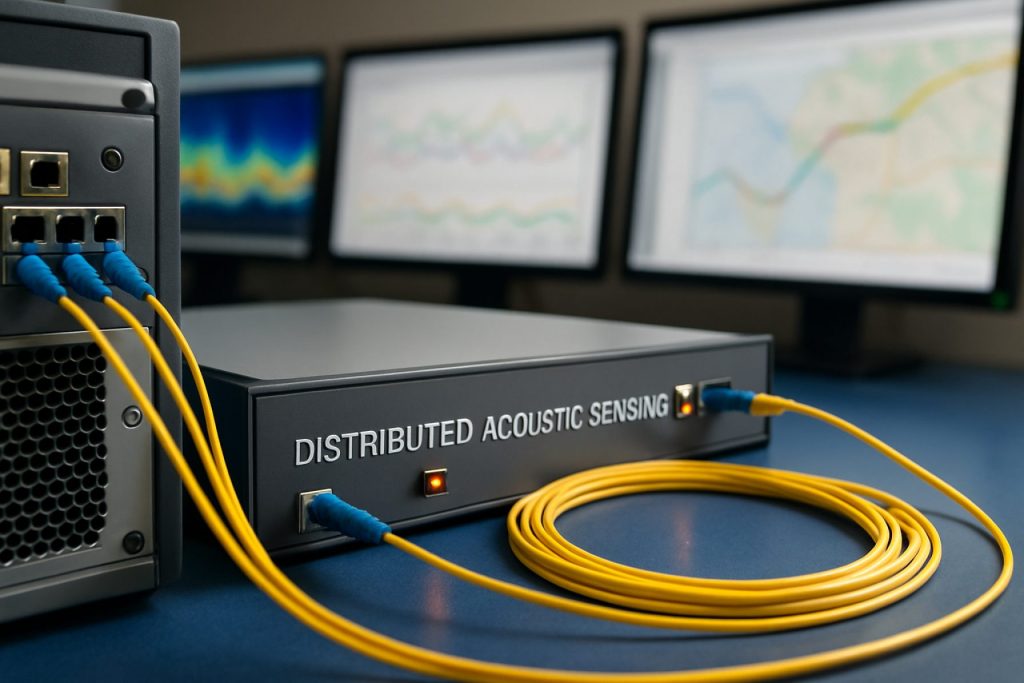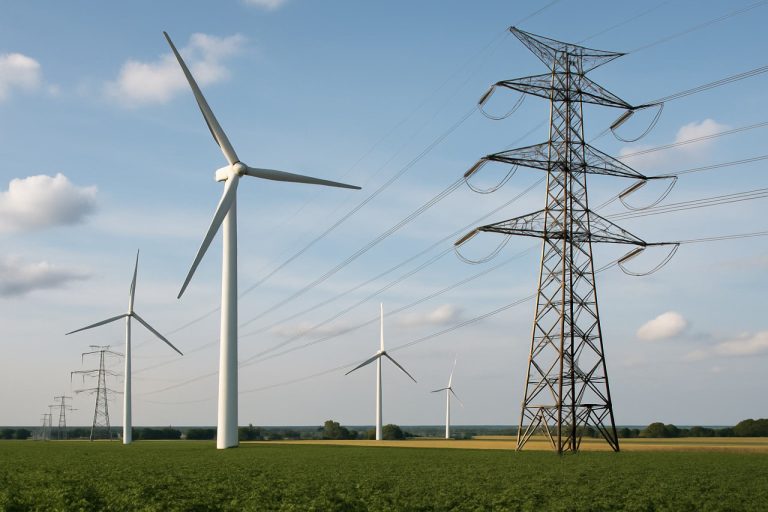
How Distributed Fiber Thermometry Systems Are Transforming Industrial Sensing in 2025: Market Growth, Technology Breakthroughs, and Strategic Outlook for the Next 5 Years
- Executive Summary: 2025 Market Highlights and Key Trends
- Market Size and Growth Forecast (2025–2030): CAGR and Revenue Projections
- Core Technologies: Distributed Temperature Sensing (DTS) and Innovations
- Key Applications: Energy, Oil & Gas, Power Grids, and Infrastructure
- Competitive Landscape: Leading Manufacturers and Strategic Moves
- Regional Analysis: North America, Europe, Asia-Pacific, and Emerging Markets
- Drivers and Challenges: Adoption Barriers and Growth Catalysts
- Regulatory Standards and Industry Initiatives
- Case Studies: Real-World Deployments and Measured Impact
- Future Outlook: Next-Gen Fiber Thermometry and Market Opportunities
- Sources & References
Executive Summary: 2025 Market Highlights and Key Trends
Distributed Fiber Thermometry Systems (DFTS) are poised for significant growth and technological advancement in 2025, driven by increasing demand for real-time, high-resolution temperature monitoring across critical infrastructure sectors. These systems, which utilize optical fibers as linear sensors, are gaining traction in industries such as power generation, oil and gas, transportation, and smart infrastructure due to their ability to provide continuous, distributed temperature profiles over long distances.
In 2025, the market is witnessing robust adoption of DFTS in power cable monitoring, pipeline leak detection, and fire detection in tunnels and industrial facilities. The push for grid modernization and the integration of renewable energy sources are accelerating the deployment of distributed fiber thermometry in electrical utilities, where early fault detection and asset health monitoring are paramount. Companies such as NKT and Prysmian Group are actively integrating distributed fiber sensing technologies into their cable solutions, enhancing operational safety and reliability.
Technological advancements in 2025 are centered on improving spatial resolution, measurement range, and system robustness. Leading manufacturers like Luna Innovations and AP Sensing are introducing next-generation distributed temperature sensing (DTS) platforms that leverage Raman and Brillouin scattering techniques for enhanced accuracy and longer sensing distances. These innovations are enabling more granular monitoring in complex environments, such as subsea pipelines and high-voltage transmission corridors.
The oil and gas sector remains a key market, with operators deploying DFTS for downhole monitoring, pipeline integrity, and leak detection. Halliburton and Baker Hughes are expanding their fiber-optic sensing portfolios to address the growing need for real-time data in reservoir management and asset protection. Additionally, the transportation sector is adopting DFTS for tunnel fire detection and rail track monitoring, with companies like Safibra providing tailored solutions for infrastructure safety.
Looking ahead, the outlook for distributed fiber thermometry systems is marked by continued innovation, expanding application fields, and increasing integration with digital platforms for predictive maintenance and smart asset management. As industries prioritize operational efficiency and safety, DFTS are expected to become a cornerstone technology in the digital transformation of critical infrastructure over the next few years.
Market Size and Growth Forecast (2025–2030): CAGR and Revenue Projections
The global market for Distributed Fiber Thermometry Systems (DFTS) is poised for robust growth between 2025 and 2030, driven by increasing demand for real-time, high-resolution temperature monitoring across critical infrastructure sectors. DFTS, leveraging technologies such as Distributed Temperature Sensing (DTS) based on optical fibers, are being rapidly adopted in industries including power generation, oil & gas, mining, and smart grid applications. The market is characterized by the presence of several established players, including AP Sensing, Luna Innovations, Halliburton, and Sensornet, each offering advanced DFTS solutions tailored to diverse industrial requirements.
In 2025, the global DFTS market is estimated to generate revenues in the range of USD 700–800 million, with a compound annual growth rate (CAGR) projected between 8% and 11% through 2030. This growth trajectory is underpinned by several factors: the expansion of smart grid infrastructure, the increasing complexity of oil & gas extraction (including subsea and unconventional resources), and the growing emphasis on safety and predictive maintenance in industrial environments. For instance, AP Sensing and Luna Innovations have reported significant contract wins in the energy and utility sectors, reflecting the accelerating adoption of distributed fiber thermometry for asset monitoring and fire detection.
Regionally, Asia-Pacific is expected to exhibit the fastest growth, fueled by large-scale infrastructure projects and the modernization of power grids in China, India, and Southeast Asia. North America and Europe remain substantial markets, driven by regulatory mandates for safety and the ongoing digital transformation of legacy assets. Companies such as Halliburton and Sensornet are expanding their offerings to address the specific needs of oilfield and utility customers in these regions.
Looking ahead, the DFTS market is likely to benefit from continued innovation in fiber optic sensing technologies, including enhanced spatial resolution, longer sensing ranges, and improved integration with digital asset management platforms. Strategic partnerships between system integrators and fiber optic manufacturers are expected to further accelerate market penetration. As industries increasingly prioritize operational efficiency and risk mitigation, distributed fiber thermometry systems are set to become a cornerstone of industrial monitoring solutions through 2030 and beyond.
Core Technologies: Distributed Temperature Sensing (DTS) and Innovations
Distributed Fiber Thermometry Systems, commonly referred to as Distributed Temperature Sensing (DTS), are at the forefront of real-time, high-resolution temperature monitoring across extensive distances. These systems utilize optical fibers as linear sensors, leveraging Raman, Brillouin, or Rayleigh scattering phenomena to detect temperature variations along the fiber’s length. As of 2025, the technology is experiencing significant advancements, driven by the increasing demand for precise thermal monitoring in sectors such as energy, infrastructure, and environmental management.
Key industry players are actively innovating in this space. Sensornet, a subsidiary of L3Harris Technologies, continues to develop DTS solutions for oil & gas, power, and industrial applications, focusing on improved spatial resolution and longer sensing ranges. AP Sensing, a global leader headquartered in Germany, is expanding its DTS product line with enhanced data analytics and integration capabilities, targeting smart grid and fire detection applications. Luna Innovations is also notable for its distributed fiber optic sensing systems, which are being adopted in structural health monitoring and pipeline leak detection.
Recent years have seen a shift toward hybrid distributed sensing, combining temperature, strain, and acoustic measurements within a single fiber. This multi-parameter approach is being pioneered by companies like Fotech Solutions (part of bp), which integrates distributed acoustic sensing (DAS) with DTS for comprehensive asset monitoring. The convergence of DTS with digital platforms and AI-driven analytics is enabling predictive maintenance and real-time anomaly detection, a trend expected to accelerate through 2025 and beyond.
In terms of technical progress, the industry is pushing the boundaries of spatial resolution—now routinely achieving resolutions below one meter over tens of kilometers of fiber. Enhanced interrogation units and advanced signal processing algorithms are reducing noise and improving accuracy, as seen in the latest offerings from Halliburton and SLB (Schlumberger), both of which are deploying DTS in challenging downhole environments.
Looking ahead, the outlook for distributed fiber thermometry systems is robust. The global push for grid modernization, renewable energy integration, and critical infrastructure resilience is expected to drive further adoption. Ongoing R&D, particularly in fiber materials and laser sources, promises even greater sensitivity and deployment flexibility. As digitalization deepens across industries, DTS will play a pivotal role in enabling safer, smarter, and more efficient operations.
Key Applications: Energy, Oil & Gas, Power Grids, and Infrastructure
Distributed Fiber Thermometry Systems (DFTS) are increasingly integral to critical sectors such as energy, oil & gas, power grids, and infrastructure, with 2025 marking a period of accelerated adoption and technological refinement. These systems utilize optical fibers as linear sensors, enabling real-time, continuous temperature monitoring over extensive distances—often tens of kilometers—making them uniquely suited for large-scale and safety-critical applications.
In the energy sector, DFTS are being deployed for enhanced monitoring of high-voltage power cables, transformers, and substations. Utilities are leveraging these systems to detect hotspots, prevent failures, and optimize asset management. For example, NKT, a leading cable manufacturer, integrates distributed temperature sensing into its high-voltage cable solutions to provide operators with actionable data for predictive maintenance and grid reliability. Similarly, Prysmian Group offers fiber-integrated cables for real-time thermal profiling, supporting the growing demand for grid modernization and resilience.
Within the oil & gas industry, DFTS are critical for downhole monitoring, pipeline leak detection, and reservoir management. Companies such as Halliburton and Baker Hughes deploy distributed fiber systems to monitor temperature profiles along wells, enabling early detection of anomalies, optimizing production, and enhancing safety. These systems are particularly valuable in unconventional and deepwater operations, where traditional sensors are impractical or unreliable.
For power grids, the transition to renewable energy and the integration of distributed energy resources are driving the need for advanced monitoring. DFTS provide utilities with the ability to monitor underground and submarine cables, transformer banks, and switchgear in real time. Southwire Company and Siemens are among the firms offering solutions that combine fiber sensing with digital platforms for grid health analytics, supporting proactive maintenance and reducing outage risks.
In infrastructure, DFTS are being adopted for structural health monitoring of bridges, tunnels, and large buildings. These systems enable continuous assessment of thermal loads and early warning of fire or overheating events. Sensornet and Brugg Cables are notable providers, supplying distributed fiber solutions for both new construction and retrofitting of critical infrastructure.
Looking ahead, the outlook for DFTS in these sectors is robust. The convergence of digitalization, stricter safety regulations, and the need for operational efficiency is expected to drive further adoption. Ongoing advancements in fiber optic technology, data analytics, and integration with IoT platforms will likely expand the range of applications and improve the cost-effectiveness of distributed fiber thermometry systems through 2025 and beyond.
Competitive Landscape: Leading Manufacturers and Strategic Moves
The competitive landscape for distributed fiber thermometry systems in 2025 is characterized by a mix of established photonics giants, specialized sensor manufacturers, and emerging technology firms. These systems, which leverage optical fibers to provide real-time, spatially resolved temperature measurements over long distances, are increasingly vital in sectors such as energy, infrastructure, and industrial automation.
Among the global leaders, Yokogawa Electric Corporation continues to hold a prominent position. The company’s DTSX series is widely deployed in power cable monitoring, fire detection in tunnels, and oil & gas pipeline management. Yokogawa’s ongoing investments in AI-driven analytics and integration with industrial IoT platforms are expected to further strengthen its market share through 2025.
Another major player, Luna Innovations, is recognized for its advanced distributed temperature and strain sensing solutions. Luna’s ODiSI and TeraMetrix product lines are used in aerospace, civil engineering, and energy applications. The company’s recent collaborations with infrastructure operators and its focus on high-resolution, real-time data acquisition position it as a key innovator in the field.
European manufacturers such as AP Sensing and Brugg Kabel are also significant contributors. AP Sensing, a spin-off from Hewlett-Packard, is known for its robust distributed temperature sensing (DTS) systems, which are deployed in fire detection, power cable monitoring, and environmental applications. Brugg Kabel, with its expertise in fiber optic cable manufacturing, has expanded its portfolio to include integrated monitoring solutions for critical infrastructure.
In Asia, Huawei Technologies has entered the distributed fiber sensing market, leveraging its telecommunications expertise to develop solutions for smart grid and pipeline monitoring. The company’s scale and R&D capabilities are expected to drive further innovation and competitive pricing in the coming years.
Strategic moves in 2025 include increased partnerships between sensor manufacturers and software analytics firms, aiming to deliver end-to-end solutions that combine hardware reliability with advanced data interpretation. There is also a trend toward modular, scalable systems that can be easily integrated into existing industrial networks, reflecting the growing demand for flexible and future-proof monitoring infrastructure.
Looking ahead, the competitive landscape is likely to see further consolidation as larger players acquire niche technology firms to expand their capabilities. The push for digital transformation in energy, transportation, and smart cities will continue to drive demand for distributed fiber thermometry systems, with leading manufacturers investing in R&D to enhance accuracy, reduce costs, and enable seamless integration with digital platforms.
Regional Analysis: North America, Europe, Asia-Pacific, and Emerging Markets
Distributed fiber thermometry systems (DFTS) are experiencing robust growth across North America, Europe, Asia-Pacific, and emerging markets, driven by increasing demand for real-time, high-resolution temperature monitoring in sectors such as energy, infrastructure, and industrial automation. As of 2025, regional dynamics are shaped by infrastructure investments, regulatory frameworks, and the pace of digital transformation.
- North America: The United States and Canada continue to lead in the adoption of DFTS, propelled by modernization of power grids, oil & gas pipeline monitoring, and the expansion of smart city initiatives. Utilities and energy companies are integrating distributed temperature sensing (DTS) for enhanced asset management and safety compliance. Major players such as Halliburton and Applied Materials are actively deploying fiber-based sensing solutions in upstream and downstream applications. The region also benefits from a strong ecosystem of technology providers and research institutions, fostering innovation in both hardware and analytics.
- Europe: Europe’s focus on renewable energy, grid modernization, and stringent safety regulations is accelerating DFTS deployment. Countries like Germany, the UK, and the Netherlands are integrating fiber thermometry in wind farms, power transmission, and railway infrastructure. Companies such as Sensornet (a QinetiQ company) and NKT are prominent in delivering distributed sensing solutions for energy and industrial sectors. The European Union’s emphasis on decarbonization and digital infrastructure is expected to further boost adoption through 2025 and beyond.
- Asia-Pacific: Rapid industrialization and urbanization in China, Japan, South Korea, and India are fueling demand for DFTS in power, transportation, and manufacturing. China, in particular, is investing heavily in smart grid and high-speed rail projects, with domestic firms like Huawei and Yokogawa Electric Corporation advancing fiber sensing technologies. The region’s focus on infrastructure resilience and safety, combined with government-backed digitalization initiatives, positions Asia-Pacific as a high-growth market through the late 2020s.
- Emerging Markets: In Latin America, the Middle East, and Africa, adoption is at an earlier stage but gaining momentum, particularly in oil & gas, mining, and utilities. Companies such as Baker Hughes are expanding their distributed sensing offerings to support asset integrity and operational efficiency in challenging environments. As infrastructure investments increase and digital transformation accelerates, these regions are expected to see significant uptake of DFTS technologies in the coming years.
Across all regions, the outlook for distributed fiber thermometry systems remains positive, with continued advancements in fiber optic technology, data analytics, and integration with industrial IoT platforms expected to drive further adoption and innovation through 2025 and beyond.
Drivers and Challenges: Adoption Barriers and Growth Catalysts
Distributed Fiber Thermometry Systems (DFTS) are gaining traction across industries due to their unique ability to provide real-time, continuous temperature monitoring over long distances and in harsh environments. As of 2025, several key drivers are accelerating adoption, while notable challenges continue to shape the market landscape.
Growth Catalysts
- Industrial Safety and Asset Monitoring: The increasing emphasis on safety and predictive maintenance in sectors such as power generation, oil & gas, and chemical processing is a primary driver. DFTS enable early detection of hotspots and thermal anomalies, reducing the risk of catastrophic failures. Major utilities and energy companies are integrating these systems to comply with stricter regulatory standards and to minimize downtime.
- Grid Modernization and Renewable Integration: The global push for grid modernization, especially with the integration of renewables, is fueling demand for advanced monitoring solutions. DFTS are being deployed for real-time temperature profiling of power cables, substations, and transformer banks, supporting grid reliability and efficiency. Companies like NKT and Prysmian Group are actively involved in supplying fiber-based monitoring solutions for high-voltage infrastructure.
- Technological Advancements: Recent improvements in fiber optic sensing technologies, such as enhanced spatial resolution and longer sensing ranges, are expanding the applicability of DFTS. Manufacturers like AP Sensing and Luna Innovations are introducing systems with improved accuracy and integration capabilities, making them more attractive for both new and retrofit projects.
- Fire Detection and Tunnel Safety: DFTS are increasingly mandated for fire detection in tunnels, metros, and critical infrastructure, driven by regulatory requirements and public safety concerns. Their ability to provide continuous, distributed temperature data is unmatched by point sensors.
Adoption Barriers
- High Initial Investment: The upfront cost of DFTS, including installation and integration with existing systems, remains a significant barrier, particularly for small and mid-sized enterprises. While operational savings are substantial over time, the capital expenditure can deter adoption.
- Technical Complexity and Skills Gap: The deployment and maintenance of DFTS require specialized knowledge in fiber optics and data analytics. The shortage of skilled personnel can slow implementation, especially in regions with less developed technical infrastructure.
- Integration Challenges: Ensuring seamless interoperability with legacy monitoring and control systems is a persistent challenge. Customization and system compatibility issues can increase project timelines and costs.
Outlook
Looking ahead to the next few years, the DFTS market is expected to benefit from ongoing digitalization trends, increased investment in smart infrastructure, and the growing need for resilient energy and transportation networks. As leading manufacturers such as NKT, Prysmian Group, AP Sensing, and Luna Innovations continue to innovate, the cost and complexity barriers are likely to diminish, paving the way for broader adoption across diverse sectors.
Regulatory Standards and Industry Initiatives
Distributed Fiber Thermometry Systems (DFTS) are increasingly subject to regulatory standards and industry initiatives as their deployment expands across sectors such as energy, infrastructure, and industrial automation. In 2025, the regulatory landscape is shaped by both international standards organizations and industry consortia, aiming to ensure interoperability, safety, and reliability of these advanced sensing technologies.
A key regulatory framework influencing DFTS is the set of standards developed by the International Electrotechnical Commission (IEC), particularly IEC 61757, which specifies performance and testing requirements for distributed fiber optic sensors, including temperature measurement. The ongoing revision and expansion of this standard in 2025 reflect the rapid technological advancements and the need for harmonized testing protocols. The International Electrotechnical Commission continues to collaborate with industry stakeholders to update these standards, ensuring they address new use cases such as high-voltage power cable monitoring and fire detection in tunnels.
In parallel, the Institute of Electrical and Electronics Engineers (IEEE) is working on guidelines for the integration of distributed fiber sensors into smart grid and industrial automation systems. These guidelines are expected to facilitate the adoption of DFTS by providing best practices for system design, data management, and cybersecurity, which are increasingly critical as these systems become part of larger digital infrastructures.
Industry initiatives are also prominent, with leading manufacturers such as AP Sensing, Luna Innovations, and NKT Photonics actively participating in standardization efforts and interoperability trials. These companies are members of industry consortia that promote open interfaces and data formats, aiming to reduce vendor lock-in and foster a competitive ecosystem. For example, AP Sensing is known for its involvement in collaborative projects that demonstrate compliance with IEC standards and support the development of new testing methodologies.
Looking ahead, regulatory bodies are expected to place greater emphasis on cybersecurity and data integrity, given the increasing integration of DFTS into critical infrastructure. The European Union’s evolving cybersecurity directives and the U.S. National Institute of Standards and Technology (NIST) guidelines are likely to influence future requirements for DFTS, particularly regarding secure data transmission and system resilience.
Overall, the regulatory and industry landscape for distributed fiber thermometry systems in 2025 is characterized by active standardization, cross-sector collaboration, and a growing focus on digital security. These efforts are set to underpin the safe and reliable deployment of DFTS in increasingly demanding environments over the next few years.
Case Studies: Real-World Deployments and Measured Impact
Distributed fiber thermometry systems (DFTS) have transitioned from laboratory prototypes to critical infrastructure tools, with real-world deployments across energy, transportation, and industrial sectors. In 2025, several high-profile case studies highlight both the operational impact and the evolving capabilities of these systems.
One of the most prominent applications is in power transmission and distribution. Utilities are increasingly deploying distributed temperature sensing (DTS) based on fiber optics to monitor underground and overhead power cables. For example, NKT, a major cable manufacturer, has integrated DTS into high-voltage cable systems to provide real-time thermal profiles, enabling dynamic line rating and early detection of hotspots. This has led to measurable reductions in unplanned outages and improved asset lifespan, as reported by utility partners in Europe and Asia.
In the oil and gas sector, distributed fiber thermometry is now standard in many upstream and midstream operations. Halliburton and Schlumberger have both deployed DTS systems in wellbores to monitor temperature changes during hydraulic fracturing and enhanced oil recovery. These deployments have enabled operators to optimize injection strategies and detect leaks or flow anomalies with meter-scale resolution, resulting in increased production efficiency and reduced environmental risk.
Railway infrastructure is another area where DFTS has demonstrated significant value. South Coast Science and Nexans have collaborated with national rail operators to install fiber-optic temperature sensors along critical track sections. These systems provide continuous monitoring for overheating in electrical cables and track beds, supporting predictive maintenance and reducing the risk of service disruptions due to thermal events.
In the industrial sector, chemical plants and refineries are leveraging DFTS for process monitoring and safety. Sensornet, a specialist in distributed sensing, has reported deployments in hazardous environments where traditional sensors are impractical. Their systems have enabled early detection of abnormal temperature rises, preventing equipment failure and improving compliance with safety regulations.
Looking ahead, the outlook for distributed fiber thermometry is robust. As fiber-optic sensor technology matures and costs decline, adoption is expected to accelerate, particularly in smart grid, renewable energy, and critical infrastructure monitoring. Industry leaders are investing in AI-driven analytics to further enhance the actionable insights derived from DFTS data, promising even greater operational impact in the coming years.
Future Outlook: Next-Gen Fiber Thermometry and Market Opportunities
Distributed fiber thermometry systems, leveraging optical fibers as continuous temperature sensors, are poised for significant advancements and market expansion in 2025 and the following years. These systems, based on Raman, Brillouin, or Rayleigh scattering, offer real-time, high-resolution temperature monitoring over tens of kilometers, making them indispensable in sectors such as energy, infrastructure, and industrial automation.
In 2025, the demand for distributed fiber thermometry is being driven by the global push for smarter, safer, and more efficient infrastructure. Power utilities are increasingly deploying these systems for real-time monitoring of high-voltage cables, transformers, and substations, aiming to prevent overheating and optimize asset management. For example, NKT, a leading cable manufacturer, integrates distributed temperature sensing (DTS) into its high-voltage cable solutions to enhance grid reliability and predictive maintenance. Similarly, Prysmian Group offers DTS-enabled cables for both energy and telecom sectors, supporting the transition to smart grids and renewable integration.
The oil and gas industry remains a major adopter, utilizing distributed fiber thermometry for downhole monitoring, pipeline leak detection, and LNG facility safety. Companies like Schlumberger and Halliburton have developed advanced DTS solutions tailored for harsh environments, enabling operators to monitor temperature profiles in real time and respond rapidly to anomalies. These capabilities are increasingly critical as the industry faces stricter safety and environmental regulations.
In parallel, the transportation and civil engineering sectors are embracing distributed fiber thermometry for structural health monitoring of tunnels, bridges, and railways. Sensornet, a specialist in distributed optical fiber sensing, provides systems that deliver continuous temperature data, supporting early detection of fire, overheating, or structural stress. This trend is expected to accelerate as urbanization and infrastructure investments grow worldwide.
Looking ahead, technological innovation is set to further enhance the performance and accessibility of distributed fiber thermometry. Advances in fiber materials, interrogation units, and data analytics are improving spatial resolution, measurement accuracy, and system robustness. Companies such as Luna Innovations are at the forefront, developing next-generation distributed sensing platforms that integrate temperature, strain, and acoustic measurements for comprehensive asset monitoring.
The outlook for distributed fiber thermometry systems is robust, with expanding applications in renewable energy (e.g., wind turbine blade monitoring), data centers, and smart cities. As digitalization and automation continue to reshape industrial landscapes, distributed fiber thermometry is expected to play a pivotal role in enabling predictive maintenance, operational efficiency, and safety across critical infrastructure worldwide.
Sources & References
- NKT
- Prysmian Group
- Halliburton
- Baker Hughes
- Safibra
- Sensornet
- L3Harris Technologies
- Fotech Solutions
- bp
- SLB (Schlumberger)
- Southwire Company
- Siemens
- Brugg Cables
- Yokogawa Electric Corporation
- Huawei Technologies
- Institute of Electrical and Electronics Engineers
- NKT Photonics
- South Coast Science
- Nexans



